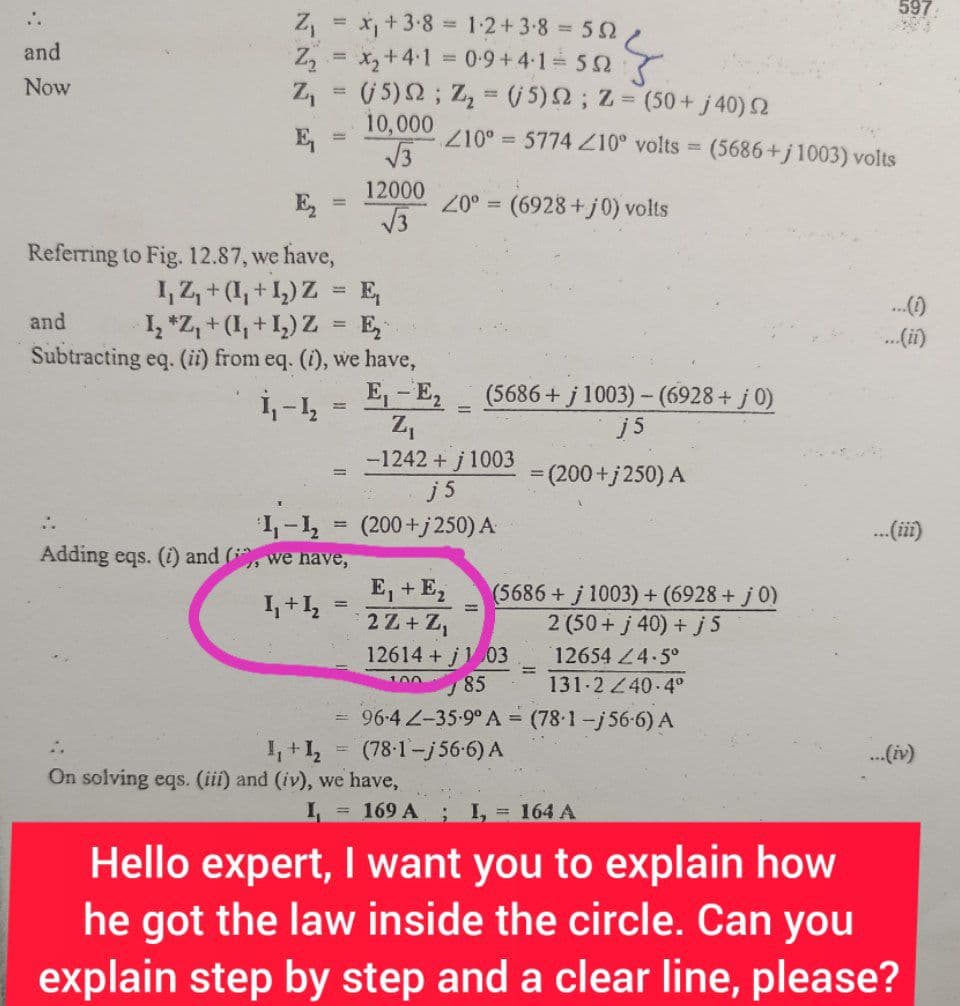and (, we have, 1₁ + 1₂ E₁ + E₂ 2 Z+Z₁ 11
Introductory Circuit Analysis (13th Edition)
13th Edition
ISBN:9780133923605
Author:Robert L. Boylestad
Publisher:Robert L. Boylestad
Chapter1: Introduction
Section: Chapter Questions
Problem 1P: Visit your local library (at school or home) and describe the extent to which it provides literature...
Related questions
Question

Transcribed Image Text:..
and
Now
Z₁ = x₁ + 38 = 1·2+38 = 552
Z₂ = x₂+41 = 0.9+4·1= 552
Z₁ = (5) 2; Z₂ = (5) 2; Z= (50+ j40) 2
210⁰ = 5774 210° volts =
E₂
=
Referring to Fig. 12.87, we have,
1₁ Z₁ + (1₁ +1₂)Z =
1₁ + 1₂
=
1₁-1₂ =
Adding eqs. (i) and (), we have,
and
1₂ *Z₁ + (1₁ + 1₂) Z
Subtracting eq. (ii) from eq. (i), we have,
1₁ - 1₂
=
10,000
√√3
12000
√√3
=
E₁
E₂
E₁-E₂
Z₁
-1242 + j1003
j5
(200+j250) A
20⁰ = (6928+j0) volts
100
:.
1₁ + 1₂
On solving eqs. (iii) and (iv), we have,
=
E₁ + E₂
2 Z+Z₁
12614+j103
(5686+j1003) - (6928+ j0)
j5
= (200+j250) A
(5686+j1003) + (6928 + j0)
2 (50+ j40) + j5
12654 24.5°
85
131-2240-4°
96-4 2-35-9° A = (78-1-j56-6) A
(78-1-j56-6) A
(5686+j1003) volts
169 A; I, = 164 A
597
...(1)
.... (iii)
...(iv)
Hello expert, I want you to explain how
he got the law inside the circle. Can you
explain step by step and a clear line, please?
Expert Solution
This question has been solved!
Explore an expertly crafted, step-by-step solution for a thorough understanding of key concepts.
Step by step
Solved in 2 steps

Knowledge Booster
Learn more about
Need a deep-dive on the concept behind this application? Look no further. Learn more about this topic, electrical-engineering and related others by exploring similar questions and additional content below.Recommended textbooks for you

Introductory Circuit Analysis (13th Edition)
Electrical Engineering
ISBN:
9780133923605
Author:
Robert L. Boylestad
Publisher:
PEARSON

Delmar's Standard Textbook Of Electricity
Electrical Engineering
ISBN:
9781337900348
Author:
Stephen L. Herman
Publisher:
Cengage Learning

Programmable Logic Controllers
Electrical Engineering
ISBN:
9780073373843
Author:
Frank D. Petruzella
Publisher:
McGraw-Hill Education

Introductory Circuit Analysis (13th Edition)
Electrical Engineering
ISBN:
9780133923605
Author:
Robert L. Boylestad
Publisher:
PEARSON

Delmar's Standard Textbook Of Electricity
Electrical Engineering
ISBN:
9781337900348
Author:
Stephen L. Herman
Publisher:
Cengage Learning

Programmable Logic Controllers
Electrical Engineering
ISBN:
9780073373843
Author:
Frank D. Petruzella
Publisher:
McGraw-Hill Education

Fundamentals of Electric Circuits
Electrical Engineering
ISBN:
9780078028229
Author:
Charles K Alexander, Matthew Sadiku
Publisher:
McGraw-Hill Education

Electric Circuits. (11th Edition)
Electrical Engineering
ISBN:
9780134746968
Author:
James W. Nilsson, Susan Riedel
Publisher:
PEARSON

Engineering Electromagnetics
Electrical Engineering
ISBN:
9780078028151
Author:
Hayt, William H. (william Hart), Jr, BUCK, John A.
Publisher:
Mcgraw-hill Education,